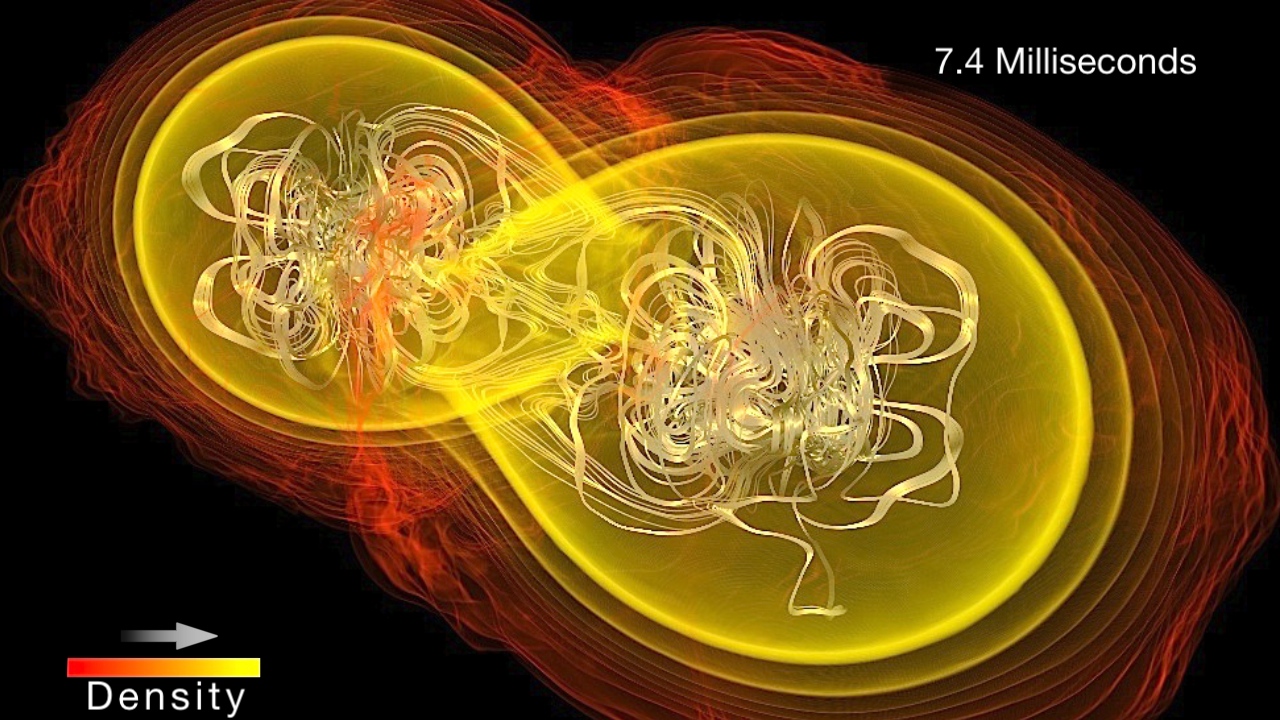Crash And Burst
Imagine a dead star the size of a city and with more mass than our sun. Now imagine two of these ultra-heavy spheres smashing into each other, generating a blast bright enough to outshine an entire galaxy. Scientists have recreated just that using supercomputers to model what happens during the collision of two neutron stars. The entire process unfolds in just 35 thousandths of a second, but what this new analysis reveals is how the tangled magnetic field lines of the collapsed neutron stars restructure around a black hole, focusing a narrow stream of particles that jet into space at 99.995 percent the speed of light. Scientists believe events like this are one source of gamma-ray bursts, the powerful flashes of light from beyond the Milky Way that were first detected by satellites in the late 1960s. Watch the visualization below to see this lightning-fast cosmic wreck evolve in super-slow motion.

Two neutron stars collide in one very big bang.
As neutron star density decays (color shift from yellow to red), a powerful magnetic field (blue, green) projects from a black hole (center).
Watch this video to learn more about what happens when neutron stars collide.

At 7.4 milliseconds after collision, the merging of two neutron stars has begun.

At 13.8 milliseconds, neutron star matter (red, orange, yellow) explodes outward while magnetic field lines (white) exist in chaotic disarray.

At 21.2 milliseconds, a dense cloud of neutron star debris forms around a black hole (center).

At 26.5 milliseconds, magnetic field lines form a disk (green) and two conical structures (white) that funnel streaming particles.

This sequence shows how magnetic field lines (green, white) restructure around a black hole (center) following a neutron star collision.
For More Information
See NASA.gov
Credits
Please give credit for this item to:
NASA's Goddard Space Flight Center
Cover and still images courtesy of NASA/AEI/ZIB/M. Koppitz and L. Rezzolla
Neutron star collision video simulation courtesy of NASA/AEI/ZIB/M. Koppitz and L. Rezzolla
-
Animators
- Dana Berry (Skyworks Digital)
- Walt Feimer (HTSI)
- Chris Smith (HTSI)
- Cruz deWilde (Avant Gravity)
- Chris Meaney (HTSI)
- Luciano Rezzolla (AEI)
- Bruno Giacomazzo (University of Maryland)
- Michael Koppitz (AEI)
-
Video editor
- Scott Wiessinger (USRA)
-
Narrator
- Erin McKinley (OSU)
-
Producer
- Scott Wiessinger (USRA)
-
Scientists
- Bruno Giacomazzo (University of Maryland)
- Luciano Rezzolla (AEI)
-
Writer
- Francis Reddy (University of Maryland College Park)
Release date
This page was originally published on Tuesday, April 3, 2012.
This page was last updated on Wednesday, May 3, 2023 at 1:53 PM EDT.
